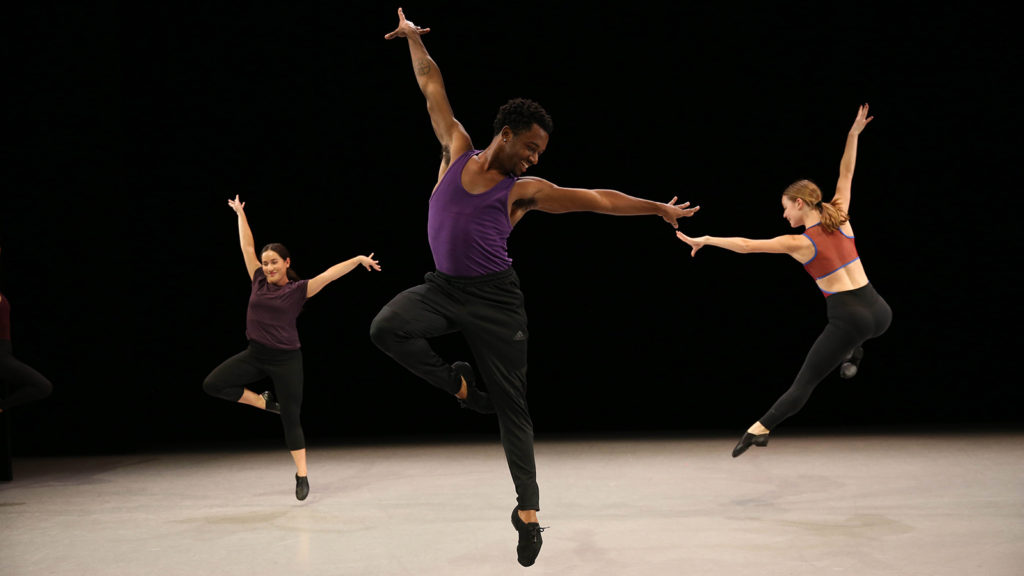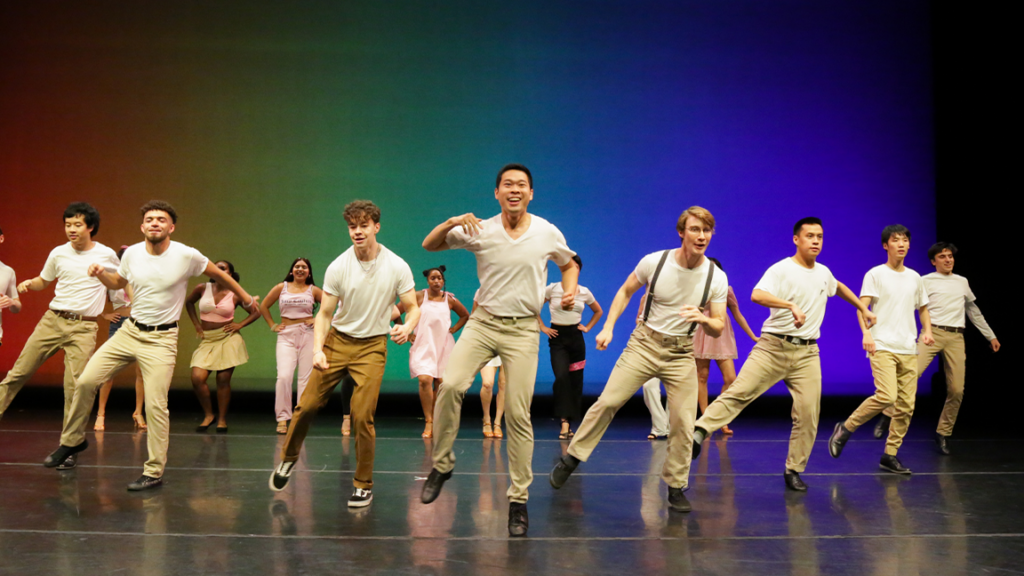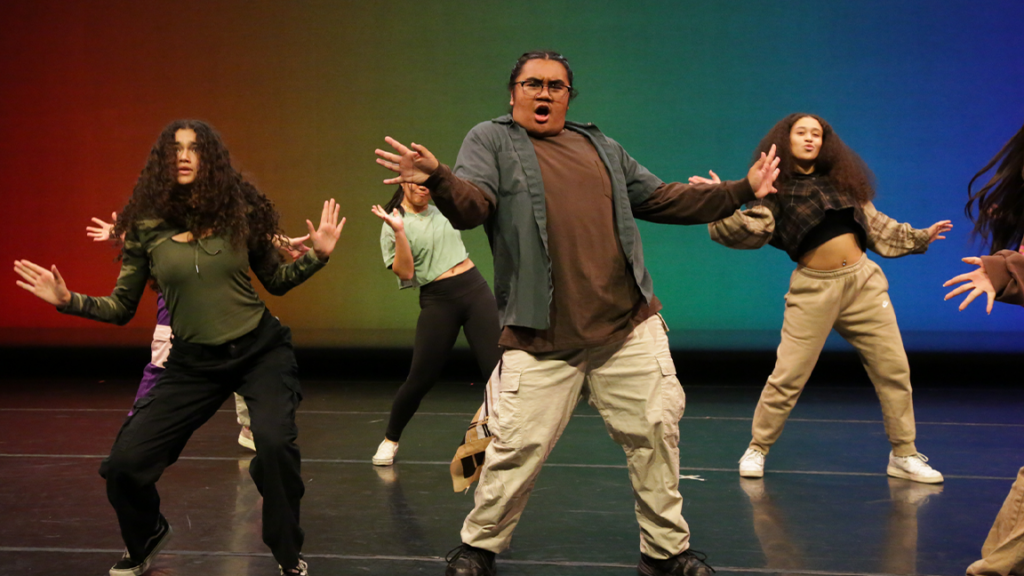Minoring in dance: the process, performances and perks
February 2, 2022

Jazz students perform choreography by Saleemah E. Knight | Photo by Benjamin Peralta
I am often asked by applicants to USC Kaufman’s BFA program: If I’m not admitted to the dance major, can I pursue another major at USC and minor in dance? The answer: Absolutely! Step into the USC Glorya Kaufman International Dance Center and you’ll find thousands of students taking technique classes in our studios or learning about dance history in our classrooms. Our large and growing population of dance minors offers robust opportunities for both lifelong practitioners and those who are new to dance.
The Glorya Kaufman International Dance Center is not only home to USC Kaufman dance majors. You’ll also find hundreds of non-major dance students who have enrolled in one of the school’s many technique and lecture courses. Whether you’ve been dancing your whole life or you’ve yet to try your first step, USC Kaufman offers a wide range of levels and styles.
“Our faculty share a deeply-held philosophy that dance is for everyone, regardless of their background or previous training,” Jennifer Lott, USC Kaufman professor, said. “We work hard to create inviting, safe and creative spaces for every single student to build a relationship with dance.”
Many non-major dance students build this relationship with dance at USC Kaufman. One step further than a non-major course, there are several options for minor programs to accommodate personal preferences. Options include the Dance Minor; the Hip-Hop, Street, and Social Dance Forms Minor; the Dance in Entertainment Minor; and the Choreography for Stage and Screen Minor, with more on the way.
In the spirit of hybridity, USC Kaufman offers a wide range of dance technique courses for non-majors, including African, Ballet, Ballroom, Contemporary, Hip-Hop, Jazz and Tap. There are also more specialized technique courses offered periodically, such as Pointe, Ballet Variations, Breaking and Musical Theater.
Declaring your dance minor
Declaring a dance minor is a relatively simple process. Students fill out a declaration form and select their program of choice. You also have the opportunity to meet with Kyle Beasley, who oversees admission to our dance minor programs. You can discuss the requirements of your intended program, discuss the perks of being a declared dance minor, and ask any questions you might have.
Each minor has a unique focus and its own upper division and total unit requirements. Apart from these, dancers can select their USC Kaufman elective courses. In this respect, each program is personalized to a dancer’s style and interests. This open approach provides you with the flexibility to work around your major courses.
Aside from the technique classes mentioned, USC Kaufman offers several lecture courses that focus on the anthropological aspect of dance education. Lectures also include discourse on dance in technology, dance on the screen, and more.
“I’ve been dancing my whole life but have never had the chance to study dance academically,” dance minor Hannah Doerr said. “It has been fascinating to learn about the history behind the movements we practice in technique courses, and to see a holistic view of dance as not only an art form but as an aspect of culture.”
And did we mention that, by taking two of our lecture courses, you can fulfill four General Education requirements?
Courses for minors and non-majors are listed in the USC Course Catalogue, as well as on the USC Kaufman website.
A dance minor’s role in the USC Kaufman dance community
Once declared, dance minors can take advantage of many benefits. Students enrolled in dance technique courses will perform with other non-majors in the Elective Experience. This showcase displays what the students have learned in their dance courses throughout the semester. Minors have access to many resources, via an exclusive online hub. Advisors post casting and choreographic opportunities from the LA dance community, along with master classes, workshops and intensives. Ultimately, USC Kaufman aims to keep minors engaged in the dance communities both at USC and Los Angeles.
Minors are also eligible to receive free tickets to performances by visiting companies off campus. And perhaps the most coveted perk: dance minors can reserve studio space in the Glorya Kaufman International Dance Center. There, they can work on course projects and continue to perfect their craft.
A wide range of dancers and abilities
In offering these resources, USC Kaufman aims to support dancers of all backgrounds and experience. This includes dance minors at the pre-professional level, who chose not to major in college but still want to continue dancing. Doerr, who came to USC with a lifetime’s worth of dance training, knew she wanted to continue in college. She particularly enjoyed Jazz C with Professor Saleemah E. Knight. The course, she says, encouraged her to be a dance scholar as well as technician.
“Professor Knight weaved a lot of history into her technique course, so I was not only learning movement, but the context of the movement and the influences that shaped them,” Doerr said.
Dance minors come from all different majors across all the schools at USC. This creates an environment rife for interdisciplinary collaboration.
“At Kaufman, we are so fortunate to have students from a wide variety of academic departments pushing minors at our school,” Kyle Beasley, Admissions and Student Services Officer and Dance Minor Advisor said. “Whether they are exploring a new passion or continuing their training, their engagement affords our program an additional layer of creative spirit.”
Weaving dance into major studies
Dance minor Emily Lu, whose major is in Media Arts + Practice at the USC School of Cinematic Arts, has also found ways to incorporate her dance minor curriculum into her primary field of study.
“When Professor Alison D’Amato showed William Forsythe’s Synchronous Objects in DANC 342: International and Historical Perspectives in Dance, I remember being completely in awe of how the project incorporated other forms of multimedia. It’s a cross section of video, code, 3D modeling and more,” Lu said.
She found the same intersections in Professor Dawn Stoppiello’s DANC 363: Dancing on the Screen course. Stoppiello explores the symbiotic relationship between dance and media.
“My various dance courses have played a tremendous part in my growing interest to create multimedia works dealing with concepts of space and movement,” Lu said. “My experience at USC Kaufman has revealed to me how multifaceted this art form truly is.”
Auxiliary clubs and communities
Doerr was former co-director and member of Break Through Hip Hop, a dance club on campus that produces a semesterly showcase. Their showcase highlights the team’s group pieces and includes guest performances from other dance clubs on campus. She is also a member of Xpressions Dance Company, a contemporary dance club that also produces their own semesterly showcase.
USC houses numerous student dance organizations on campus, across several different styles. Some even travel internationally to present work. Beasley works with student representatives from these dance clubs through the SC Dance Community (SCDC), which brings together over a dozen groups to promote the spirit of dance to the university community. SCDC also hosts events for the community, as well as informal showcases.
Break Through and Xpressions are two of these clubs, and one of many ways to get involved in dance on campus. By working together, USC Kaufman and SCDC give the dance community at USC space for abundant growth.
Learn more about USC Kaufman’s dance minor curriculum.
By Celine Kiner and updated by Anne Aubert-Santelli, Associate Dean of Academic and Student Life

